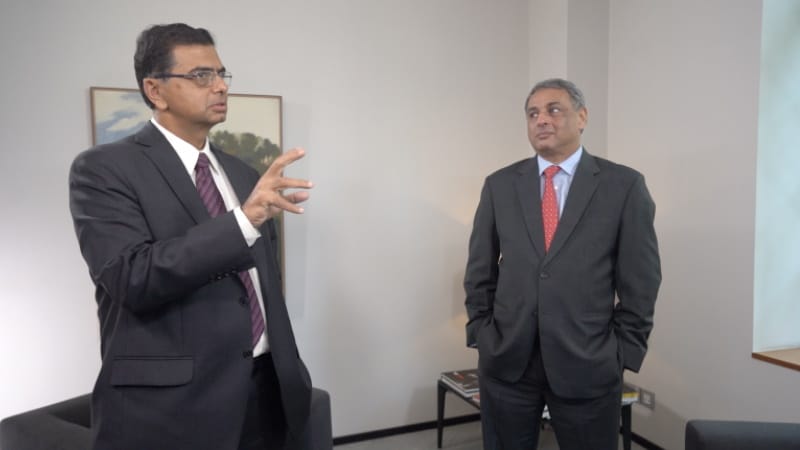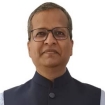Fast forward

T.V. Narendran (right), CEO & Managing Director, Tata Steel, in conversation with Sanjeev Krishan, Chairperson, PwC in India, on the winning leap in the nation-building narrative.
Excerpts from the conversation.
Sanjeev: Welcome to the first edition of Immersive Outlook. Today, we have in our midst T.V. Narendran, CEO at Tata Steel, who has been generous with his time to provide his perspectives on India’s aspirations to be a developed economy over a period of time and what it needs to do to get there. Naren, thank you so much for your time this morning. Let’s start with the first one: we are going to celebrate 75 years of India’s Independence and Tata as a group and Tata Steel have played a huge role in nation building. What are your perspectives on the journey so far?
Narendran: I think Tata Steel was the original Atmanirbharata story. It was set up saying that India should be self-sufficient in steel, and that we should have strong educational institutions. So Tata Steel was conceived and created with that in mind. I think over the last hundred years we have proved many critics wrong at different points in time and done reasonably well. We have played a very important role in nation building even before we got independence and after that as well. We have been an important part of a lot of the infrastructure that has been built in India, we are an important part of the automobiles that are built in India, appliances that are built in India. More than anything else we do a lot of work for the communities where we operate and that’s been the ethos of the group and a legacy of the founding values of the group which we have tried to live with.
Sanjeev: I would say that there would be very few people who would not know of the contribution the group has made to society at large. As you look to the future, at 25 years from now, we are embarking on our expansionist phase. We believe that India could look very different in 2047. We have grown very well on the services side, the composition of the GDP is changing very rapidly. If India has to achieve the status of a developed economy by 2047 and [I] am going beyond the USD 5 trillion economy, what do you think we need to do to meet that aspiration? As a nation what should we do more of and what should we do less of to meet that aspiration?
Narendran: The concept of India is something which has really been tested and been strengthened since independence. We are such a culturally and geographically diverse country. So to stick together despite such diversity is really a shining example of how a country can be created and can develop. We should certainly preserve all the good things that we have done ever since Independence in the last 75 years. We are a diverse country with different voices and democracy as a way to run the country is best exemplified in India. Everyone feels that they have a voice and I think that matters a lot. We are also a very federal country. You have the Centre and the states.
The second part is obviously to continue to build for the future, build the physical infrastructure, digital infrastructure, the human capital that is required, and prepare the country for the future. I think the government is talking more and more about that, about doing a lot more. If you look at the physical infrastructure, the kind of money that we are spending today is great. I think we need to keep doing that for many years to come. In digital infrastructure, I think we are ahead of many countries that are richer than us. I think it’s also very important to drive inclusion in our country. We also need to encourage a lot more entrepreneurism. We need to have more and more job creators. We obviously have a lot of job seekers but I am happy to see that over the last 20–-30 years, many iconic companies have been created, industries are being created and the startup ecosystem is very exciting. So I think there is a lot happening which we should be proud of.
Going forward, issues which concern the world are inequality. We need to see how to address that. We need to look at climate change, and as we create a future we can have a more carbon-efficient path to development than many other countries who developed over the last few decades, including the rich countries of today. I think there is so much to do whereby we can create a future which is very different from the future that is being created by the countries who are ahead of us.
Sanjeev: I think that there are some key messages for all of us. Considering the pace at which the country has progressed in recent years, do you think we spend enough time on thinking about the future ? What’s your perspective?
Narendran: That’s always a problem, whether it’s at the state level or at the industry level or at a company level. You tend to get so bogged down by the issues of today that you sometimes don’t spend enough time on the future. Even if you look at the Indian ecosystem, I think there are some of the best policies in place. But the execution of those policies is a challenge. We should make a habit of thinking about the future in a multigenerational way, not just in terms of the next few years.
Sanjeev: I think that again resonates with me. Someone mentioned to me that for leaders, 70% of the time should go into thinking about the future and maybe 30% should be to manage what they are dealing with at the moment. But it invariably ends up being the other way round… There’s a huge narrative that India would be in a good position considering the geopolitics of the world. Do you see that potential coming through?
Narendran: I see that potential coming through more now than in the past simply because we have been talking about this potential for a very long time. Often times, the gap between the potential and the reality has been quite big; but that gap is reducing, which is good. I think we have no choice but to bridge that gap. One of the reasons why we have a lot of potential is because we are a young country in terms of demographics. But that demographic dividend can become a demographic liability if you really don’t create enough jobs and opportunities. So I think there is a need for us to translate the potential into a reality. I think we are moving maybe faster in that direction and we need to continue to move even faster. A lot of work needs to be done there.
I think the focus on building the physical and digital infrastructure are steps in the right direction. Geopolitically, I think we are in a very good position today as countries across the world are looking at an option beyond China. India’s unique; not only can we be a great source but we are also a great market. So, you can scale up in India for India and for the world. That’s an opportunity very few countries offer.
Sanjeev: Moving from the macro to the micro, you talked about technology that has been a huge disruptor for businesses. As a manufacturing business, how have you leveraged technology in whatever you do ?
Narendran: We pretty much service all segments of the economy, so we watch very carefully how technology is disrupting our customers across the value chain – where it is in the auto industry, construction industry or any other industry. We look at how we can harness technology for two things – drive cost efficiencies within our ecosystem and have very different stakeholder experiences.
Tata Steel has been actually at the forefront of this digital transformation journey. Our sites in Europe and India have been recognised by the World Economic Forum as Digital Lighthouses. This recognition is given to manufacturing sites that have been ahead of others in implementing digital technologies. The irony of it is that the three sites out of our five sites which have been recognised are in the Netherlands and Jamshedpur – both more than 100 years old, and Kalinga Nagar, a newer site less than five years old. So the new and old have transformed and I think that’s a great opportunity for us.
Because of our investments in technology, we have been able to transition even as a manufacturing company during the pandemic. We could operate plants with a much lower level of workforce, ensure social distancing, work in pods and small teams within the manufacturing plant.
Today, after COVID-19, we are very flexible. Employees can decide along with the team where they want to work from – home, workplace or from anywhere. So technology provides great opportunities. But if you don’t understand it or are not watching it, it can be a threat.
Sanjeev: Well said. Another disruptor is climate change and the broader ESG agenda. Everybody has been talking about fossil fuels and what’s good and what’s not good. Today, there is cost inflation and there is pressure that may deter people from going on that path. You have global businesses. How do you see Tata Steel responding to this potential conundrum which is in the minds of many?
Narendran: This is a very important subject for us in Tata Steel, because steel is one of the hard to abate sectors. Steel accounts for a high carbon footprint, but on the flip side, it is the most commonly used metal in the world. Recently, there was an article which said there are four or five materials which you can’t do without, but which emit a lot of carbon. Steel is one of them. The good news is there are technologies available today, but they need to be scaled up at a very fundamental level so that you can recycle steel. Steel is infinitely recyclable, so if the energy sources are green, green steel can be mad.
Today, steel is made from iron ore using coal. Tomorrow, you could substitute coal with gas as gas is available in plenty and thereafter substitute gas with hydrogen. So, that’s the process route steel industries are looking at. In Europe, we are moving quite fast because the ecosystem there with the policy framework, infrastructure for gas, hydrogen, etc., has been created much faster than it has in the rest of the world. When gas is available in the eastern part of India, we will start using gas instead of coal.
I think, however, at a larger level we should not underestimate the cost and complexity of this transition. The cost of steel is going to go up and has to be, in some sense, shared between the industry and customers. Both will have to bear part of this cost and the government should help with this transition. I think it needs to be a coordinated effort between the multiple agencies involved.
Sanjeev: Recently, we had export tax on steel coming in. What are your views on that and also broadly on policy intervention in business?
Narendran: Policy stability is more important than anything else. So today, when we invest in building a steel plant and it is set to come up three years from now or five years from now, you cannot have policy flip-flop. I don’t think one should penalise an industry or a company for making money if you do it the right way. Further, at an industry level, India is in a unique position because it has iron ore. Most countries who are exporting steel today – the biggest exporters of steel are China, Korea and Japan – import iron ore. If they can export 150 million tonnes of steel between them after importing iron ore, there is no reason why India which has iron ore shouldn’t be able to export 150 tonnes of steel.
This iron ore in India lies in some of the poorest parts of the country. Steel companies are investing in the poorest parts, creating jobs for many, away from the urban centres. So, for multiple reasons, we should encourage an industry which is leading private sector investment in India, creating jobs in all these places.
India should be a big exporter of steel. India hardly exports 10–15 million tonnes of steel. Why can’t India be a 100-million-tonne exporter of steel?
I feel from a strategic point of view, it’s a bad idea to tax steel exports. From a policy point of view again, tax policy flip-flop confuses investors, particularly if you are looking at attracting foreign investments. Foreign investors will look at policy stability more than anything else. Indian investors may be a bit more indulgent, but I think foreign investors will really look hard at policy.
Sanjeev: That point is very well made. Let’s get to the social infrastructure, the human capital and the cultural issues. These, in some ways, are pivotal for any kind of transformation, as it is the people who deliver. What role have they played in Tata Steel’s transformation journey?
Narendran: We constantly encourage people to keep thinking about the future. We are blessed with very passionate and committed employees. In fact, at the lower levels of workers, we even have sixth-generation employees. So that’s a kind of emotional commitment people have towards the company.
This is good news and bad news. The good news is they are willing to do anything for the company. The bad news is you tend to get stuck in the past and keep talking of this was what used to happen.
So how do you preserve what has been good and how do you preserve what needs to be preserved? Apart from all the targets that we set ourselves, at a very fundamental level, we have said that as an organisation, we have to be future ready and that means you have to be structurally future ready, culturally future ready and financially future ready.
Structurally future ready and financially future ready are higher level responsibilities with the board and with the management leadership because that’s about portfolio choices that you make and the KPIs you drive and the financials you deliver.
The cultural future readiness is something which can’t be done unless the whole organisation participates and that needs to be led by the leadership. You need to walk the talk; you need to do what you want others to do. Culture change can be driven only if you personify that culture. So there are multiple things that we took on at multiple points in time and embedded those in the organisation. I think at Tata Steel we have a way to pick up something and run with it in the organisation. For instance, we started about five to six years ago on our digital technology journey. We started by sending our leadership team across the world to look at what was happening, see companies harnessing technology, understand it. We had a lot of ideas from the shop floor. We encourage people to come up with ideas on how to use technology to make a difference to daily life.
So it was not top down but also bottom up. We had training with a lot of reverse mentoring. All of us in the leadership team including me had a reverse mentor – someone who is less than 30 years old who spent time with us. This was a good way for us to engage with the younger demographic, as well as learn something new. We got the Institute of Sustainability Leadership, University of Cambridge, to come and talk not just to our board members and leadership team, but also the union leaders so that they understood climate change as much as most of us did. So, it was not something that the management talked about but even the organisation understood why it was important for the future of the company.
Today, we are looking at how we can transform into an agile way of working because all said and done, there’s a lot of bureaucracy. So we have a team called the Bureaucracy Busters whose job is to bust bureaucracy in some sense. So a lot of these initiatives are going on and people are committed and passionate about creating a future for the company, and once they are convinced it picks up its own momentum.
Sanjeev: I think there are a few leadership lessons for me there. Thank you so much, Naren, for that one. I will move to the last segment. We are all looking at creating more outcomes, better outcomes, but some of those outcomes and the quality of those outcomes are going to be predicated on how much trust you can build in your ecosystem. Trust could be a huge value accreditor, it could be a value generator. How do you view this?
Narendran: Trust is the most difficult thing to build and the easiest thing to mess up. Also, you cannot assume that if you build trust in one place, you can easily build the same trust in another place, particularly as we are growing inorganically in multiple locations we have to invest in building that trust.
It may be easier for Tata Steel to build trust when it acquires Bhushan Steel in India because everyone knows Tata Steel. When you go overseas and acquire a company, you need to work harder as they may not know you as well as somebody in India knows you. Even within India we built trust in Jamshedpur for over 100 years; but when we went to Kalinga Nagar, we assumed the same level of trust and had a problem. We couldn’t start the project for five years because the local communities didn’t accept us and we had not invested enough in building trust with them. So trust manifests itself in different ways. People join you because they trust you, vendors are happy to deal with you because they trust you. So, I think it manifests itself in many ways and I think it’s the most valuable asset that you can build.
Sanjeev: Absolutely. Our two pillars are trust and outcomes, so I can’t agree with you more on that. But let me ask you the last question: if you envision India of 2047, what do you think India of 2047 will look like?
Narendran: Well, hopefully and obviously the second or third largest economy in the world. I mean at 2047, we should hopefully continue to be a vibrant, successful democracy, which is the second or third largest economy in the world. I think that is something we should all aspire for, but how we get there is also equally important. We should be proud of what we have achieved in the first 75 years of our independence. There are so many institutions that we have built. I think we need to make sure that we strengthen those institutions and when we get to 2047, we have a country that all of us are proud to be part of, proud to be living in.
I also think we need to address the issue of inequality as that’s a growing issue which is manifesting itself in different ways. You can’t have a USD 20 trillion economy with only part of the population receiving its benefits. At a more fundamental level, we need to focus on health and provide healthcare to large sections of society. We also need to address employability which means both education and vocational skills, and of course employment – and create good quality jobs so that we can tap into the human capital that exists in our country.
Sanjeev: Naren, thank you so much. While we may not be here, I am quite certain that the generations ahead of us will do us proud.
Narendran: While we will not be here, I am sure the institutions will be here.
Sanjeev: Definitely. We look forward.
Ends
















